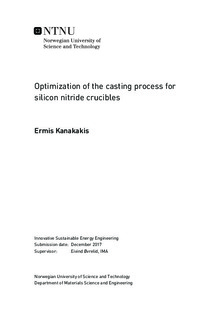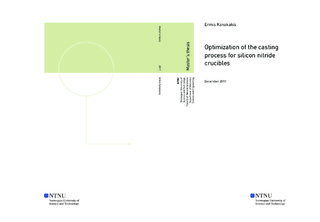| dc.description.abstract | As renewable energy sources get to replace conventional fossil fuel power plants, solar cells will come to play a major role. For this purpose, their efficiency must be enhanced and their cost minimized in order to compete with alternative forms of power such as hydroelectric or wind. A major part of the cost during solar cell fabrication belongs to the expense for the crucible required for crystal growth. So far, on industrial scale, crucibles are non-reusable, which means that they need to be replaced after each use. The aim of this work was to:
1) Test the influence of oxidation on the wetting properties of Si3N4
2) Define alternative types of coatings for directional solidification casting of Si
3) Develop a new process for casting in small crucibles
Surface oxidization of Si3N4 reduces its wettability and acts as a barrier that prevents impurity diffusion into the silicon melt during solidification. Small Si$_3$N$_4$ samples were heat-treated under various temperatures and durations. Surface oxidation and the formation of a silicon oxynitride layer were tested. Afterwards, four cylindrical and four conical Si$_3$N$_4$ crucibles were heat-treated at 1200oC in order to get their surfaces oxidized. All of the cylindrical crucibles were destroyed by cracks and excessive flaking during heat-treatment or coating. Three of the conical ones were further treated using different coatings and one was left uncoated. The coatings were: a) Normal Si$_3$N$_4$ powder; b) Colloidal silica mixed with Si3N4; c) BaO intermediate layer and normal Si3N4 on top. P-type silicon ingots were grown in all of them. Subsequently, the ingots were removed and cut in order to be characterized. The ingot grown in the uncoated crucible was strongly attached to the substrate and was impossible to remove. Finally, samples from the rest three ingots were acquired and characterized by measuring their resistivity, minority carrier lifetime and impurity concentration (interstitial oxygen and substitutional carbon).
The ingot grown in the crucible with normal Si3N4 powder coating showed the highest average lifetime. The ingot from the colloidal silica mix was very clean which means that the mechanical stability of the coating had increased. It also had the lowest oxygen concentration, a fact which suggests that coating dissolution into the melt had been limited. However, metallic impurities from the crucible had killed lifetime completely. Finally, the ingot from the BaO coated crucible showed no particular improvement in comparison to the normal one and its fluctuating resistivity suggests that a lot of oxides had formed during solidification. | |

